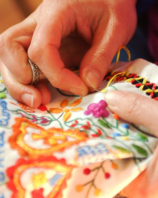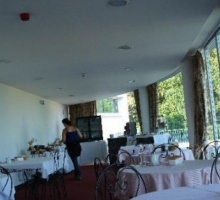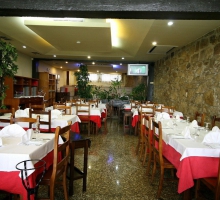Some people claim that the origin of the Valentine’s love scarves, come from the noble’s scarves of the 17th-18th century, transformed later on by the women of the people, transposing them a simpler configuration whether with its words, or in the techniques and materials used in their creation.These "handkerchiefs" formed part of the ladies' outfit and may have assumed two purposes: decorative utility and conquering of the boyfriend.
Relatively to the boyfriend, when the girls reached the marriage age, they prepared their "handkerchief" embroidered through a fine linen cloth or a cotton handkerchief with the knowledge they had on cross-stitch, since they had been taught by their mothers or grandmothers.
Once the "handkerchief" was embroidered, the girl would send it to the boy who she had chosen to be her boyfriend. She would be corresponded if he wore it visibly, and if it so happened, it would be the beginning of a romantic relationship.
However, the "Valentine lover’s' scarves" have been through changes such as the cross-stitch partially replaced by the continuous stitch and the initial colours of black and red gave upsurge of diverse colours. These "handkerchiefs" were, in fact, the expressive simplicity of love and naivety of the girls’ feelings.
Embroidered with feelings
The "Valentine/Lover’s Scarves" are a strong cultural heritage present in the daily life of the Vila-verdenses. These embroideries designed on fine linen or cotton, show a practical and gracious way on how the ladies used the existing natural resources in the municipality of Vila Verde.The love feelings described on the "Valentine/Lovers’ Scarves", done in cross-stitch and, usually in the evenings, took a long time until their conclusion.
The popular verses, supported by the religious themes, the nature, the grape harvest, the emigration to Brazil-ship and dove who carries the letter and the lush colours of the lines, revealed the feelings of their authors for a certain boy who, if he was interested in dating, undertook this relationship by putting the scarf around his neck. If the girl would not be the perfect match, the boy returned his handkerchief.
The scarves carried therefore, romantic feelings of the girls when they were old enough to get married, revealed by romantic symbols such as loyalty, dedication and friendship.
Location: Vila Verde
Relatively to the boyfriend, when the girls reached the marriage age, they prepared their "handkerchief" embroidered through a fine linen cloth or a cotton handkerchief with the knowledge they had on cross-stitch, since they had been taught by their mothers or grandmothers.
Once the "handkerchief" was embroidered, the girl would send it to the boy who she had chosen to be her boyfriend. She would be corresponded if he wore it visibly, and if it so happened, it would be the beginning of a romantic relationship.
However, the "Valentine lover’s' scarves" have been through changes such as the cross-stitch partially replaced by the continuous stitch and the initial colours of black and red gave upsurge of diverse colours. These "handkerchiefs" were, in fact, the expressive simplicity of love and naivety of the girls’ feelings.
Embroidered with feelings
The "Valentine/Lover’s Scarves" are a strong cultural heritage present in the daily life of the Vila-verdenses. These embroideries designed on fine linen or cotton, show a practical and gracious way on how the ladies used the existing natural resources in the municipality of Vila Verde.The love feelings described on the "Valentine/Lovers’ Scarves", done in cross-stitch and, usually in the evenings, took a long time until their conclusion.
The popular verses, supported by the religious themes, the nature, the grape harvest, the emigration to Brazil-ship and dove who carries the letter and the lush colours of the lines, revealed the feelings of their authors for a certain boy who, if he was interested in dating, undertook this relationship by putting the scarf around his neck. If the girl would not be the perfect match, the boy returned his handkerchief.
The scarves carried therefore, romantic feelings of the girls when they were old enough to get married, revealed by romantic symbols such as loyalty, dedication and friendship.
Location: Vila Verde





